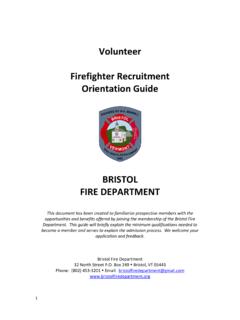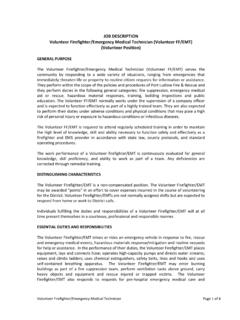Transcription of Volunteer Firefighter Recruitment and Retention …
1 1 Volunteer Firefighter Recruitment and Retention formative Research Results Prepared for National Volunteer Fire Council March 2015 Report | SalterMitchell Inc. 2 TABLE OF CONTENTS Challenge .. 3 Research Goals .. 3 Methodology .. 4 Executive Summary .. 5 Detailed Findings .. 8 Appendix A ..24 Appendix B ..34 3 CHALLENGE The number of Volunteer firefighters and emergency responders in the United States is declining about 12 percent in just the past three decades leaving nearly half of communities atincreased risk during emergencies.
2 This declining number of volunteers coincides with an increased call volume that has tripled in that time, and an increased public expectation for more and better quality fire and rescue services. The National Volunteer Fire Council is seeking a nationwide strategy for improving Volunteer Firefighter Recruitment and Retention . The obvious starting point is to get more interested individuals in the door. The key questions are: who are these interested individuals, why are they interested in this opportunity, and what will lead them to actively Volunteer with their local Volunteer fire and rescue departments?
3 RESEARCH GOALS In 2013 and 2014, NVFC conducted department surveys examining Recruitment and Retention challenges and successes across the nation. In the Fall of 2014, NVFC expanded upon this by conducting target audience research with Salter>Mitchell to better understand the key attitudes and motivators of current volunteers, and of those who are interested in volunteering with the Volunteer fire and rescue service. To understand the key attitudes and motivating factors that lead an individual from being interested in volunteering to actively volunteering, we must examine: People's interest in volunteeringoWhat proportion of the population is interested in pursuing Volunteer opportunities?
4 Who are they demographically and psycho-graphically? Where are these peoplelocated? People s awareness of local needs and opportunitiesoAre people aware of their local community s need for volunteers? Do people knowhow to get in touch if they are interested? People s attitudes towards volunteeringoWhat do people think about Volunteer firefighters ? What do people think about beinga Volunteer Firefighter ? How does this align with interested individuals values andexpectations? Drivers of current and future behavioroHow are doers and non-doers similar and different?
5 How does this influence anon-doer s probability of volunteering? 4 METHODOLOGY The initial phase of formative research included a rapid research review conducted in September 2014. This review consisted of an in-depth analysis of existing Recruitment and Retention campaigns and fire department survey data, a review of presentation and discussion notes from the September 2014 Fall NVFC SAFER work group meeting, and the completion of an informal Recruitment and Retention focus group with NVFC board members on September 19, 2014.
6 Additionally, six one-on-one interviews were conducted with Volunteer fire service professionals during the period of September 17-19, 2014. The second phase of formative research consisted of an omnibus online survey completed by 1,224 adults (age 18+). The demographically representative sample was selected based on Census data for age, ethnicity, gender, region, and income. The survey included 4 questions and was fielded September 29 - October 1, 2014. The third phase of formative research included two, three-day qualitative discussion sessions ( bulletin boards ) conducted online during the period of October 21-23, 2014.
7 One discussion board, the doers, included 24 active Volunteer firefighters of mixed demographics, recruited by NVFC and Salter>Mitchell. The other board of non-doers included 24 participants of various demographics who exhibited a strong or moderate interest in volunteering with the Volunteer fire and emergency services, recruited by Salter>Mitchell. 5 EXECUTIVE SUMMARY The below outlines the higher level insights provided by the Volunteer Firefighter Recruitment campaign formative research: Interest in Volunteering Results from the online omnibus survey provided insight on individuals interest in volunteering.
8 There is substantial interest in operational Volunteer opportunities nationwide, with 29%of survey respondents indicating a high level, or a moderate level of interest in volunteerfirefighting and first responder opportunities ( , definitely interested; mightbe interested. )oWhen examining the role of age, interest was significantly higher among the 18-34 segment with 44% of 18-34 year olds showing interest in operationalvolunteer opportunities (13% definitely interested; 31% might be interested. )oLevel of interest did not significantly vary when examining the role of respondents exhibited as much, if not more, interest in operationalvolunteer opportunities as Caucasian/White respondents.
9 Roughly 40% of survey respondents indicated interest in volunteering non-operationallywith a local Volunteer department (fundraising, safety/prevention education, Recruitment ,other).o20% of survey respondents indicated an interest in helping volunteerdepartments of survey respondents indicated an interest in helping volunteerdepartments in fire safety and prevention educational of Local Needs and Opportunities Results from the online omnibus survey provided insight on individuals awareness of local Volunteer needs.
10 Respondents indicated low recognition of need for Volunteer firefighters and emergencyresponders in their of respondents said they do not know if their local department is lookingfor volunteers. Respondents indicated low knowledge of whether their local fire and rescue departmentwas a Volunteer , combination, or career Towards Volunteer firefighters and Volunteer Firefighting Responses to the qualitative discussion boards assessed twelve key behavioral determinants in order to provide insights to doer and non-doer attitudes towards Volunteer firefighting.












